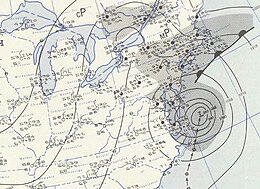Hurricane Carol
| Category 3 major hurricane (SSHWS/NWS) | |

Surface weather analysis of Carol on August 31
|
|
| Formed | August 25, 1954 |
|---|---|
| Dissipated | September 1, 1954 |
| Highest winds |
1-minute sustained: 115 mph (185 km/h) |
| Lowest pressure | 955 mbar (hPa); 28.2 inHg |
| Fatalities | 72 total |
| Damage | $462 million (1954 USD) |
| Areas affected | Bahamas, North Carolina, New York, New England, southern Quebec |
| Part of the 1954 Atlantic hurricane season | |
Hurricane Carol was among the worst tropical cyclones on record to affect the states of Connecticut and Rhode Island in the United States. It developed from a tropical wave near the Bahamas on August 25, 1954, and slowly strengthened as it moved northwestward. On August 27, Carol intensified to reach winds of 105 mph (165 km/h), but weakened as its motion turned to a northwest drift. A strong trough of low pressure turned the hurricane northeastward, and Carol later intensified into a major hurricane. While paralleling the Mid-Atlantic and Southeastern United States, the storm produced strong winds and rough seas that caused minor coastal flooding and slight damage to houses in North Carolina, Virginia, Washington, D.C., Delaware, and New Jersey. The well-organized hurricane accelerated north-northeastward and made landfall on eastern Long Island, New York, and then over eastern Connecticut on August 31 with sustained winds estimated at 110-mph and a barometric pressure near 956 mb. Carol transitioned into an extratropical cyclone over New Hampshire later on August 31, 1954.
In New York, strong winds on Long Island damaged about 1,000 houses, left 275,000 people without electricity, downed many trees, and resulted in heavy crop losses. Storm surge flooded LaGuardia Airport and inundated the Montauk Highway, which left the eastern portion of Long Island isolated. Carol also brought strong winds and rough seas to coastal Connecticut, Rhode Island, and southeastern Massachusetts. Throughout the region, about 150,000 people were left without electricity and telephone service. 1,545 houses were destroyed and another 9,720 were damaged. Approximately 3,500 cars and 3,000 boats were destroyed. There were 65 deaths and 1,000 injuries in New England. The storm caused an additional $1 million in damage in Canada as well as two deaths. Overall, Carol caused 72 fatalities and damage totaled $462 million (1954 USD), making it the costliest hurricane in the history of the United States, at the time. Following the storm, Carol was retired, becoming the first name to be removed from the naming lists in the Atlantic basin.
...
Wikipedia
